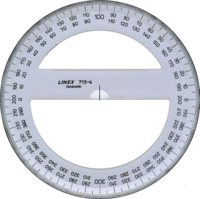Centesimal degree
The centesimal degree or gon —also called gradian (plural: gradians, not to be confused with radian) and gonio b>— is a unit of measure for plane angles, an alternative to the sexagesimal degree and the radian. The value of a centesimal degree is defined as the central angle subtended by an arc, whose length is the four hundredth (1/400) part of a circumference. Its symbol is a small ge, in superscript, placed after the number in question; for example, 12.4574g. The centesimal degree, as well as the sexagesimal degree, does not belong to the International System of Units.
Because the circumference is divided into 400 gon, for example a right angle is equal to 100 gon, which allows us to determine that a hundredth degree is equivalent to nine tenths of the sexagesimal degree.
The name gon is usually restricted to specialized fields of topography and civil engineering, where this unit of measurement is widely used to define the value of angles. The name gradian is used in calculators, where it is usually represented by the English term gradian.
History
There was a previous name for this unit as degree centigrade. To avoid confusion, in 1948 the homonymous unit of temperature was officially renamed degree Celsius, although degrees Celsius is still popularly called centigrade. This is partially incorrect, since the Kelvin scale is also centigrade (it is a scale that takes reference from 100 equal parts, in this case, the freezing and boiling point of distilled water) and the term would be ambiguous.
Relation to the size of the Earth
According to the definition of the meter used in 1889, one kilometer should correspond to the length of a meridian arc whose amplitude is one centesimal minute; although later more precise measurements of the size of the Earth showed that differences exist.
Equivalences
The centesimal degree arises from the division of the Cartesian plane into four hundred equal angles, with a common vertex. Each quadrant has a width of 100 grads, and the sum of the four quadrants measures 400 grads.
- Equivalence between grades sexagesimales and centesimales
- 0° = 0g
- 90° = 100g
- 180° = 200g
- 270° = 300g
- 360° = 400g
- Example
The following angular values are equivalent:
- 23° 47' 35" degrees sexagesimales
- 23,7931 degrees sexagesimales with decimal fraction
- 26g 43c 67cc gons with minutes and seconds
- 26,4367g goals or degrees centesimales
Minutes and seconds in gon correspond to the decimal fraction of gon, whereas degrees sexagesimals do not. Gradients should not be confused with the use of decimal fractions to express angles in sexagesimal degrees.
Its divisors are:
- 1 centesimal grade = 100 centesimal minutes (100m or 100c)
- 1 minute centesimal = 100 seconds centesimales (100s or 100cc)
Conversion of common angles
| Units | Values | |||||||
|---|---|---|---|---|---|---|---|---|
| Revolution | 0 | Δ Δ 12{displaystyle {tfrac {tau }{12}}} | Δ Δ 8{displaystyle {tfrac {tau }{8}}}} | Δ Δ 6{displaystyle {tfrac {tau }{6}}}} | Δ Δ 4{displaystyle {tfrac {tau }{4}}}} | Δ Δ 2{displaystyle {tfrac {tau }{2}}}} | 34Δ Δ {displaystyle {tfrac {3}{4}}tau } | 1Δ Δ {displaystyle 1tau ,} |
| Grades (sexagesimales) | 0° | 30° | 45° | 60° | 90° | 180° | 270° | 360° |
| Radian | 0 | π π 6{displaystyle {tfrac {pi }{6}}}} | π π 4{displaystyle {tfrac {pi }{4}}}} | π π 3{displaystyle {tfrac {pi }{3}}} | π π 2{displaystyle {tfrac {pi }{2}}}} | π π {displaystyle pi ,} | 3π π 2{displaystyle {tfrac {3pi }{2}}}} | 2π π {displaystyle 2pi ,} |
| Gradians (grades) centesimales) | 0g | 100g3{displaystyle {tfrac {100^{rm {g}}{3}}}{3}}}}} | 50g | 200g3{displaystyle {tfrac {200^{rm {g}}{3}}}{3}}}}} | 100g | 200g | 300g | 400g |
Difference between radian, gradian, and sexagesimal degree
All three are units of measure for plane angles, and they differ as follows:
- Radian (rad): arch whose length is the radius.
- Gradián or centesimal grade (g): arch whose length is the quadrennestème (1/400) part of a circumference.
- Sexagesimal Grade°): arch whose length is the three hundredth sexagésima (1/360) part of a circumference.
Contenido relacionado
Michel Rolle
Triode
Heliocentric orbit
















